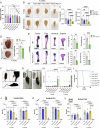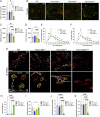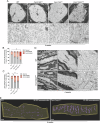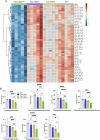Fam134c and Fam134b shape axonal endoplasmic reticulum architecture in vivo
- PMID: 39039299
- PMCID: PMC11316074
- DOI: 10.1038/s44319-024-00213-7
Fam134c and Fam134b shape axonal endoplasmic reticulum architecture in vivo
Abstract
Endoplasmic reticulum (ER) remodeling is vital for cellular organization. ER-phagy, a selective autophagy targeting ER, plays an important role in maintaining ER morphology and function. The FAM134 protein family, including FAM134A, FAM134B, and FAM134C, mediates ER-phagy. While FAM134B mutations are linked to hereditary sensory and autonomic neuropathy in humans, the physiological role of the other FAM134 proteins remains unknown. To address this, we investigate the roles of FAM134 proteins using single and combined knockouts (KOs) in mice. Single KOs in young mice show no major phenotypes; however, combined Fam134b and Fam134c deletion (Fam134b/cdKO), but not the combination including Fam134a deletion, leads to rapid neuromuscular and somatosensory degeneration, resulting in premature death. Fam134b/cdKO mice show rapid loss of motor and sensory axons in the peripheral nervous system. Long axons from Fam134b/cdKO mice exhibit expanded tubular ER with a transverse ladder-like appearance, whereas no obvious abnormalities are present in cortical ER. Our study unveils the critical roles of FAM134C and FAM134B in the formation of tubular ER network in axons of both motor and sensory neurons.
Keywords: Axon; Endoplasmic Reticulum; FAM134B; FAM134C.
© 2024. The Author(s).
Conflict of interest statement
The authors declare no competing interests.
Figures










References
-
- Berkane R, Ho-Xuan H, Glogger M, Sanz-Martinez P, Brunello L, Glaesner T, Kuncha SK, Holzhuter K, Cano-Franco S, Buonomo V et al (2023) The function of ER-phagy receptors is regulated through phosphorylation-dependent ubiquitination pathways. Nat Commun 14:8364 10.1038/s41467-023-44101-5 - DOI - PMC - PubMed
MeSH terms
Substances
Grants and funding
LinkOut - more resources
Full Text Sources
Molecular Biology Databases

